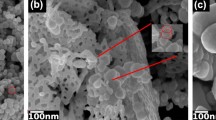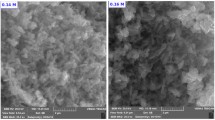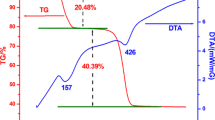Abstract
Zinc oxide nanostructures have extensive industrial and biomedical applications. In this paper, ZnO nanoparticles are synthesized by facile and low-cost sol–gel method. The effect of synthesis parameters including precursor material (zinc nitrate and zinc acetate), solution pH, and aging time is investigated on the structural, morphological, and optical properties of ZnO nanoparticles. The results reveal that using zinc acetate leads to an extensively uniform distribution of nanoparticles. Also, the dimensions of ZnO rod-like nanoparticles are significantly affected by precursor material and pH of the solution, in such a way that the aspect ratio of nanorods increased/decreased with increasing pH for the samples synthesized from zinc acetate/zinc nitrate. The structural characterization shows that all the samples are formed in the hexagonal phase. So, the precursor material, solution pH, and even aging time do not significantly influence the crystalline phase of ZnO nanoparticles. However, they significantly affect the crystallite size. The characteristic vibration modes of hexagonal ZnO are observed in the Raman and FTIR spectra of all the samples. A broad absorption band in the range of 220–420 nm is detected in the diffuse reflectance (DRS) spectra of all the samples. The bandgap of the samples is not significantly affected by the synthesis parameters. Moreover, the best synthesis condition for obtaining a sample with high absorption and low backscattering in the absorption band is determined by comparing UV–Vis–NIR and DRS results. The aging of samples synthesized using zinc acetate at pH of 13 declares that aging time can control the morphology without crystalline phase transition.
Graphical abstract


















Similar content being viewed by others
References
E. Sánchez-López et al., Metal-based nanoparticles as antimicrobial agents: an overview. Nanomaterials 10(2), 292 (2020)
H. Mirzaei, M. Darroudi, Zinc oxide nanoparticles: biological synthesis and biomedical applications. Ceram. Int. 43(1), 907–914 (2017)
R. Mohammed et al., Green ZnO nanorod material for dye degradation and detoxification of pharmaceutical wastes in water. J. Env. Chem. Eng. 8(5), 104295 (2020)
K. Rambabu et al., Green synthesis of zinc oxide nanoparticles using Phoenix dactylifera waste as bioreductant for effective dye degradation and antibacterial performance in wastewater treatment. J. Hazard. Mater. 402, 123560 (2021)
M. Uribe-López et al., Photocatalytic activity of ZnO nanoparticles and the role of the synthesis method on their physical and chemical properties. J. Photochem. Photobiol. A Chem. 404, 112866 (2021)
X. Zhao, M. Li, X. Lou, Sol–gel assisted hydrothermal synthesis of ZnO microstructures: morphology control and photocatalytic activity. Adv. Powder Technol. 25(1), 372–378 (2014)
Q. Li et al., Highly sensitive sensor based on ordered porous ZnO nanosheets for ethanol detecting application. Sens. Actuators B Chem. 326, 28952 (2021)
X. Shen et al., Synthesis and photocatalytic performance of ZnO with flower-like structure from zinc oxide ore. J. Mater. Sci. Technol. 51, 1–7 (2020)
M.L. Addonizio et al., Sol–gel synthesis of ZnO transparent conductive films: the role of pH. Appl. Surf. Sci. 305, 194–202 (2014)
A. Badnore, A. Pandit, Effect of pH on sonication assisted synthesis of ZnO nanostructures: process details. Chem. Eng. Process. 122, 235–244 (2017)
K. Sambath et al., Morphology controlled synthesis of ZnO nanostructures by varying pH. J. Mater. Sci. Mater. Electron. 23(2), 431–436 (2012)
P. Chand, A. Gaur, A. Kumar, Structural and optical properties of ZnO nanoparticles synthesized at different pH values. J. Alloy. Compd. 539, 174–178 (2012)
S. Alias, A. Ismail, A. Mohamad, Effect of pH on ZnO nanoparticle properties synthesized by sol–gel centrifugation. J. Alloy. Compd. 499(2), 231–237 (2010)
M.M. Ba-Abbad et al., Optimization of process parameters using D-optimal design for synthesis of ZnO nanoparticles via sol–gel technique. J. Ind. Eng. Chem. 19(1), 99–105 (2013)
M.M. Ba-Abbad et al., The effect of process parameters on the size of ZnO nanoparticles synthesized via the sol–gel technique. J. Alloy. Compd. 550, 63–70 (2013)
D.A.M. Osman, M.A. Mustafa, Synthesis and characterization of zinc oxide nanoparticles using zinc acetate dihydrate and sodium hydroxide. J Nanosci Nanoeng 1(4), 248–251 (2015)
H. Ahmadian, F.S. Tehrani, M. Aliannezhadi, Hydrothermal synthesis and characterization of WO3 nanostructures: effects of cap** agent and pH. Mater. Res. Exp. 6(10), 105024 (2019)
N.C. Castillo et al., Flame-assisted synthesis of nanoscale, amorphous and crystalline, spherical BiVO4 with visible-light photocatalytic activity. Appl. Catal. B 95(3–4), 335–347 (2010)
F.S. Tehrani, H. Ahmadian, M. Aliannezhadi, High specific surface area micro-mesoporous WO 3 nanostructures synthesized with facile hydrothermal method. Eur. Phys. J. Plus 136(1), 1–11 (2021)
S. Esmaeili, M. Ehsani, M. Fazli, Photo-catalytic activities of La0.7Ba 0.3 MnO3 nanoparticles. Optik 216, 164812 (2020)
V. Russo et al., Multi-wavelength Raman scattering of nanostructured Al-doped zinc oxide. J. Appl. Phys. 115(7), 073508 (2014)
R. Sato-Berrú et al., Micro-Raman investigation of transition-metal-doped ZnO nanoparticles. J. Raman Spectrosc. Int. J. Original Work Aspects Raman Spectrosc. Incl. High. Order Process. Brillouin Rayleigh Scatter. 38(9), 1073–1076 (2007)
G.J. Exarhos, S.K. Sharma, Influence of processing variables on the structure and properties of ZnO films (Pacific Northwest Lab., Richland, WA, 1995)
S. Alamdari, M.S. Ghamsari, M.J. Tafreshi, Optimization of Gallium concentration to improve the performance of ZnO nanopowders for nanophotonic applications. Ceram. Int. 46(4), 4484–4492 (2020)
M. Abbaspoor, M. Aliannezhadi, F.S. Tehrani, Effect of solution pH on as-synthesized and calcined WO3 nanoparticles synthesized using sol–gel method. Opt Mater 121, 111552 (2021)
M. Jamali, F.S. Tehrani, Effect of synthesis route on the structural and morphological properties of WO3 nanostructures. Mater. Sci. Semicond. Process. 107, 104829 (2020)
M. Hansen et al., Single nanomaterial level investigation of ZnO nanorod sulfidation reactions via position resolved confocal Raman spectroscopy. Nanoscale 11(3), 1147–1158 (2019)
R.F. Garcia-Sanchez et al., Thermal effects associated with the Raman spectroscopy of WO3 gas-sensor materials. J. Phys. Chem. A 117(50), 13825–13831 (2013)
V. Galstyan et al., Nanostructured ZnO chemical gas sensors. Ceram. Int. 41(10), 14239–14244 (2015)
R. Wang, G. Xu, P. **, Size dependence of electron-phonon coupling in ZnO nanowires. Phys Rev B 69(11), 1133 (2004)
Y. Song et al., Raman spectra and microstructure of zinc oxide irradiated with swift heavy ion. Curr. Comput.-Aided Drug Des. 9(8), 395 (2019)
M. Šćepanović et al., Modification of the structural and optical properties of commercial ZnO powder by mechanical activation. Sci. Sinter. 38(2), 169–175 (2006)
A. Muravitskaya et al., Enhanced Raman scattering of ZnO nanocrystals in the vicinity of gold and silver nanostructured surfaces. Opt. Express 24(2), A168–A173 (2016)
J. Wang et al., Annealing properties of ZnO films grown using diethyl zinc and tertiary butanol. J. Phys. Condens. Matter 17(10), 1719 (2005)
K. Handore et al., Novel green route of synthesis of ZnO nanoparticles by using natural biodegradable polymer and its application as a catalyst for oxidation of aldehydes. J. Macromol. Sci. Part A 51(12), 941–947 (2014)
O.M. Ntwaeaborwa et al., Structural, optical and photoluminescence properties of Eu3+ doped ZnO nanoparticles. Spectrochim. Acta Part A Mol. Biomol. Spectrosc. 182, 42–49 (2017)
S.P. Rajendran, K. Sengodan, Synthesis and characterization of zinc oxide and iron oxide nanoparticles using Sesbania grandiflora leaf extract as reducing agent. J. Nanosci. (2017). https://doi.org/10.1155/2017/8348507
M. Pudukudy, Z. Yaakob, Facile synthesis of quasi spherical ZnO nanoparticles with excellent photocatalytic activity. J. Cluster Sci. 26(4), 1187–1201 (2015)
M. Arakha et al., Zinc oxide nanoparticle energy band gap reduction triggers the oxidative stress resulting into autophagy-mediated apoptotic cell death. Free Radical Biol. Med. 110, 42–53 (2017)
E.A. Meulenkamp, Synthesis and growth of ZnO nanoparticles. J. Phys. Chem. B 102(29), 5566–5572 (1998)
J. Li, D. Yang, X. Zhu, Effects of aging time and annealing temperature on structural and optical properties of sol–gel ZnO thin films. Aip Adv. 7(6), 065213 (2017)
Author information
Authors and Affiliations
Corresponding author
Rights and permissions
About this article
Cite this article
Sheikhi, S., Aliannezhadi, M. & Shariatmadar Tehrani, F. Effect of precursor material, pH, and aging on ZnO nanoparticles synthesized by one-step sol–gel method for photodynamic and photocatalytic applications. Eur. Phys. J. Plus 137, 60 (2022). https://doi.org/10.1140/epjp/s13360-021-02252-8
Received:
Accepted:
Published:
DOI: https://doi.org/10.1140/epjp/s13360-021-02252-8




